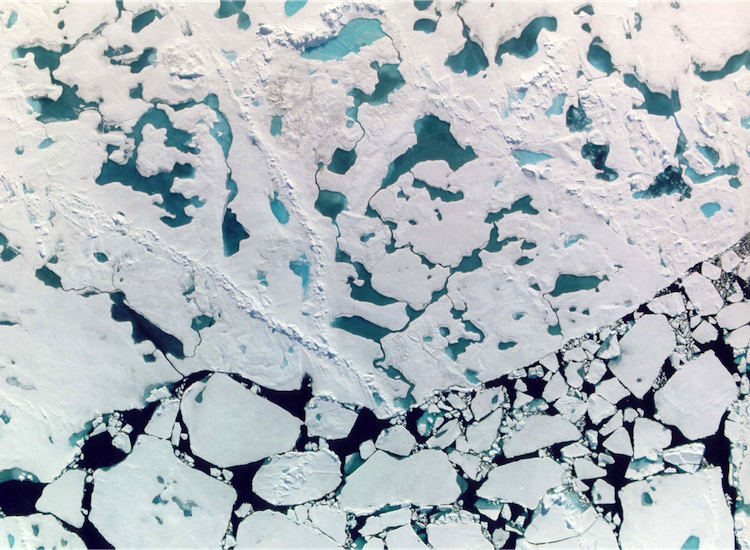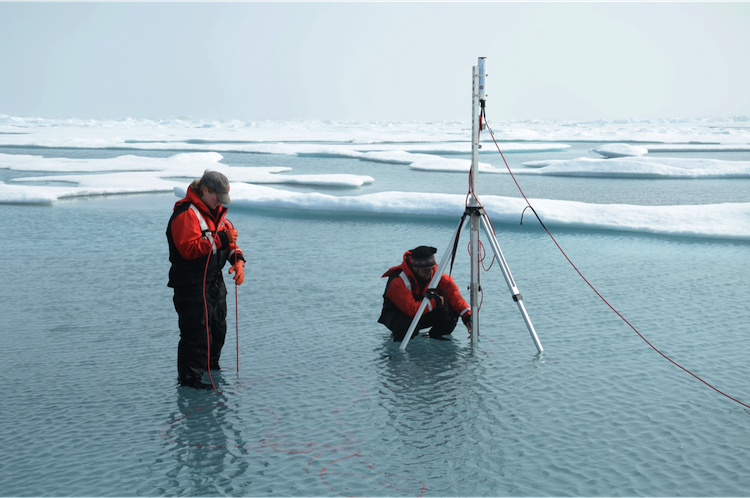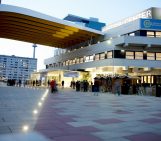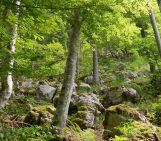Each September, battered by the relentless sun-filled days of summer, the smooth expanse of the Arctic Ocean reaches the climax of its annual transformation. Replacing the endless blanket of winter ice, a vast jigsaw puzzle stretches across the pole, a mosaic of soggy snow islands floating amid turquoise ponds of meltwater and inlets of dark blue sea. These meltwater ponds have been shown to dramatically accelerate melt rates during the boreal summer, contributing to the decline in Arctic sea ice extent. Now, new research suggests that the influence of meltwater ponds doesn’t end when the mercury begins to drop: ponds may delay the regrowth of sea ice by up to two months, further reducing Arctic sea ice volume by up to 20 percent.
Meltwater ponds grow as existing sea ice melts and the meltwater pools on its surface, covering up to 80 percent of young sea ice and up to 40 percent of older ice. Once formed, the meltwater allows the ice to absorb more solar radiation by lowering its albedo (the amount of sunlight it reflects), and also acts as a reservoir of latent heat. As a result, “the more ponds you have, the more melting you will have,” says Daniela Flocco, a postdoc at the Centre for Polar Observations and Modeling at the University of Reading in the UK and the lead author of the new work, presented this week at the General Assembly of the European Geosciences Union.
In her new study, however, she focuses on what happens next: “In September, the ponds are at their maximum extent. Now you have to do something with all that water.” Some of it will be flushed away, leaked through cracks in the ice, or otherwise lost, but some ponds will persist and these ponds must freeze before new sea ice begins to grow. That’s because the way the ice forms depends on the difference in the temperature between the air and the ocean. The ponds lie in between and their warmth changes the equation.
Winter regrowth takes place at the bottom of existing ice as frigid Arctic air temperatures permeate down through the ice, coaxing the water temperature at the ice interface below the freezing point. But the presence of meltwater ponds reverses this gradient; instead of cold temperatures at the top of the sea ice, the meltwater remains at the freezing point, preventing the seawater below from cooling. “That actually stops the freezing at the bottom of the sea ice in the places where you have a pond,” Flocco says. Flocco and her collaborators are developing a relatively simple thermodynamic model to represent and explore the effect of this previously unrecognised process on sea ice dynamics using complex global climate models (GCM).
The results of her preliminary work, conducted in collaboration with Daniel Feltham and others, suggest that meltwater ponds impede regrowth of sea ice until nearly all of the meltwater has refrozen, a process that can take months owing to the depths of some ponds (which can exceed one metre) and to their salinity. Ponds start out slightly salty because they form from sea ice, which contains inclusions of seawater. During refreezing, a lid of ice forms over the pond and grows thicker, excluding salt from the new ice and concentrating it in the water that remains. Because saltier water freezes at a lower temperature, somewhat paradoxically, the more a pond has refrozen, the harder it gets to refreeze the rest.
On average, Flocco says, meltwater ponds can delay regrowth of sea ice by approximately one and a half months, a significant fraction of the regrowth season. When she implemented her new calculations into the Los Alamos Sea Ice Model (abbreviated CICE), she found that the model predicted a 20 percent reduction in Arctic sea ice volume over an area of 5.5 million square kilometres during the growth period between late August and mid-October if pond dynamics were considered compared to when they were omitted (which has been the norm until now).
However, validating the model estimates will require new observational studies, says Don Perovich, a sea ice researcher at the United States Army’s Cold Regions Research and Engineering Laboratory, who has conducted numerous field campaigns in the Arctic and was not involved in the new work. “I’ve seen the initial phase of pond freeze-up at the end of summer,” Perovich says, confirming the presence and growth of the ice lids Flocco simulates in her model. Due to the harsh conditions in of the Arctic winter, however, he has never observed what happens next. “Experimentally, it would be interesting to follow a variety of ponds through winter.”
It would also be important because meltwater ponds constitute a major uncertainty in sea ice modeling, Perovich says. Flocco thinks delayed refreezing due to meltwater ponds might have cascading effects. Not only do ponds form more readily on more vulnerable, younger ice, but “the more you delay refreezing, the more you get thinner ice,” she says, “and you never know how long it will take for the ice to start growing again properly.”
By Julia Rosen, PhD, Freelance Science Writer
Reference:
Flocco et al., 2014: The impact of refreezing of melt ponds on Arctic sea ice thinning. Geophysical Research Abstracts, Vol. 16, EGU2014-4125





Pingback: A double threat to Arctic ice | julia rosen